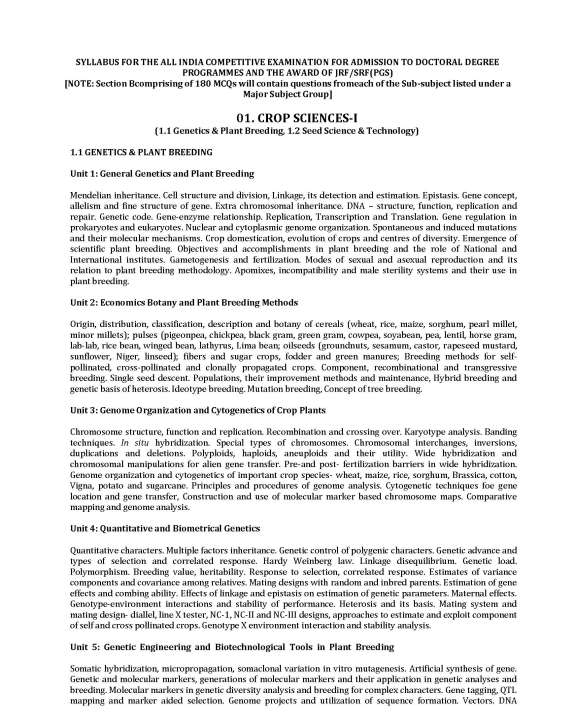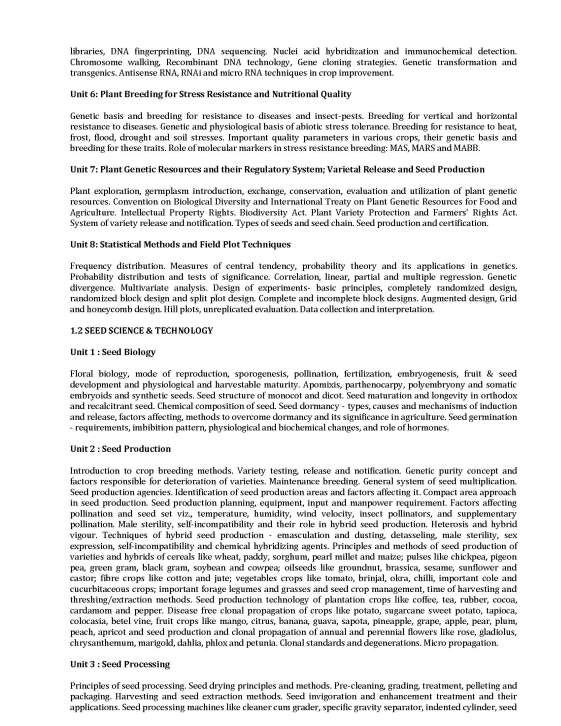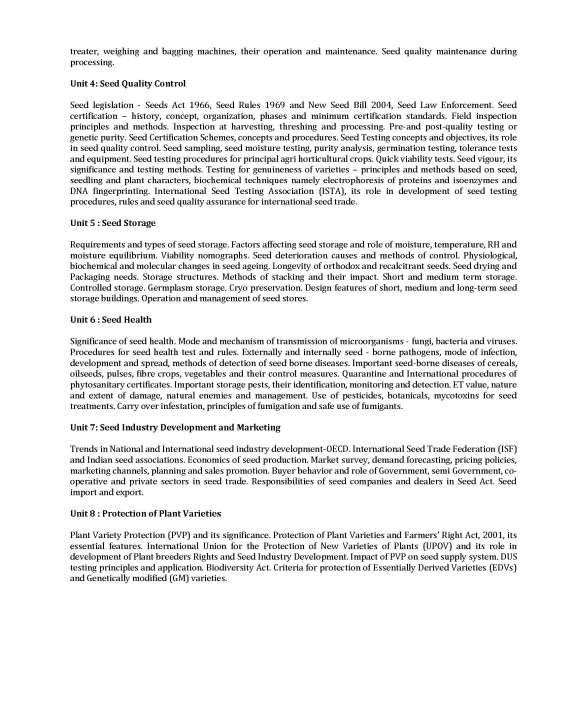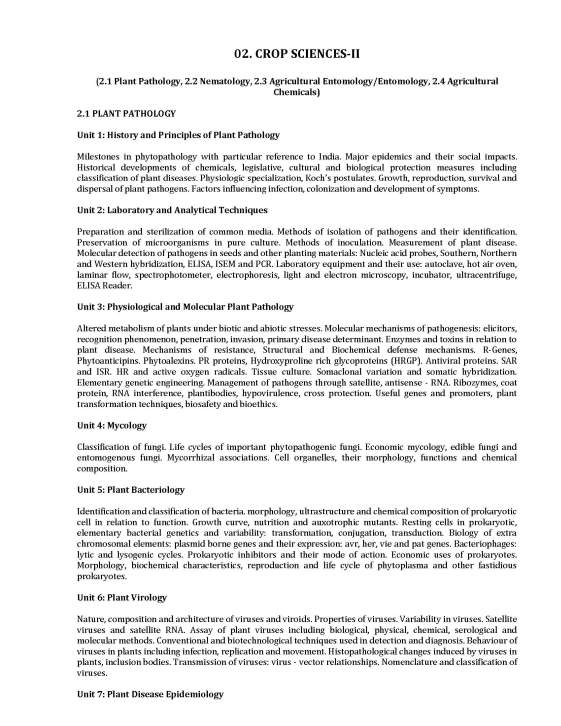|
#1
25th September 2014, 12:00 PM
| |||
| |||
| ICAR JRF Syllabus for Soil Science
I am looking for ICAR JRF exam Soil Science Syllabus, can you please provide here??? As you are asking for Indian Council of Agricultural Research (ICAR) JRF Soil Science paper syllabus so on your demand I am providing same : 01. CROP SCIENCES-I (1.1 Genetics & Plant Breeding, 1.2 Seed Science & Technology) 1.1 GENETICS & PLANT BREEDING Unit 1: General Genetics and Plant Breeding Mendelian inheritance. Cell structure and division, Linkage, its detection and estimation. Epistasis. Gene concept, allelism and fine structure of gene. Extra chromosomal inheritance. DNA structure, function, replication and repair. Genetic code. Gene-enzyme relationship. Replication, Transcription and Translation. Gene regulation in prokaryotes and eukaryotes. Nuclear and cytoplasmic genome organization. Spontaneous and induced mutations and their molecular mechanisms. Crop domestication, evolution of crops and centres of diversity. Emergence of scientific plant breeding. Objectives and accomplishments in plant breeding and the role of National and International institutes. Gametogenesis and fertilization. Modes of sexual and asexual reproduction and its relation to plant breeding methodology. Apomixes, incompatibility and male sterility systems and their use in plant breeding. Unit 2: Economics Botany and Plant Breeding Methods Origin, distribution, classification, description and botany of cereals (wheat, rice, maize, sorghum, pearl millet, minor millets); pulses (pigeonpea, chickpea, black gram, green gram, cowpea, soyabean, pea, lentil, horse gram, lab-lab, rice bean, winged bean, lathyrus, Lima bean; oilseeds (groundnuts, sesamum, castor, rapeseed mustard, sunflower, Niger, linseed); fibers and sugar crops, fodder and green manures; Breeding methods for selfpollinated, cross-pollinated and clonally propagated crops. Component, recombinational and transgressive breeding. Single seed descent. Populations, their improvement methods and maintenance, Hybrid breeding and genetic basis of heterosis. Ideotype breeding. Mutation breeding, Concept of tree breeding. Unit 3: Genome Organization and Cytogenetics of Crop Plants Chromosome structure, function and replication. Recombination and crossing over. Karyotype analysis. Banding techniques. In situ hybridization. Special types of chromosomes. Chromosomal interchanges, inversions, duplications and deletions. Polyploids, haploids, aneuploids and their utility. Wide hybridization and chromosomal manipulations for alien gene transfer. Pre-and post- fertilization barriers in wide hybridization. Genome organization and cytogenetics of important crop species- wheat, maize, rice, sorghum, Brassica, cotton, Vigna, potato and sugarcane. Principles and procedures of genome analysis. Cytogenetic techniques foe gene location and gene transfer, Construction and use of molecular marker based chromosome maps. Comparative mapping and genome analysis. Unit 4: Quantitative and Biometrical Genetics Quantitative characters. Multiple factors inheritance. Genetic control of polygenic characters. Genetic advance and types of selection and correlated response. Hardy Weinberg law. Linkage disequilibrium. Genetic load. Polymorphism. Breeding value, heritability. Response to selection, correlated response. Estimates of variance components and covariance among relatives. Mating designs with random and inbred parents. Estimation of gene effects and combing ability. Effects of linkage and epistasis on estimation of genetic parameters. Maternal effects. Genotype-environment interactions and stability of performance. Heterosis and its basis. Mating system and mating design- diallel, line X tester, NC-1, NC-II and NC-III designs, approaches to estimate and exploit component of self and cross pollinated crops. Genotype X environment interaction and stability analysis. Unit 5: Genetic Engineering and Biotechnological Tools in Plant Breeding Somatic hybridization, micropropagation, somaclonal variation in vitro mutagenesis. Artificial synthesis of gene. Genetic and molecular markers, generations of molecular markers and their application in genetic analyses and breeding. Molecular markers in genetic diversity analysis and breeding for complex characters. Gene tagging, QTL mapping and marker aided selection. Genome projects and utilization of sequence formation. Vectors. DNA libraries, DNA fingerprinting, DNA sequencing. Nuclei acid hybridization and immunochemical detection. Chromosome walking, Recombinant DNA technology, Gene cloning strategies. Genetic transformation and transgenics. Antisense RNA, RNAi and micro RNA techniques in crop improvement. Unit 6: Plant Breeding for Stress Resistance and Nutritional Quality Genetic basis and breeding for resistance to diseases and insect-pests. Breeding for vertical and horizontal resistance to diseases. Genetic and physiological basis of abiotic stress tolerance. Breeding for resistance to heat, frost, flood, drought and soil stresses. Important quality parameters in various crops, their genetic basis and breeding for these traits. Role of molecular markers in stress resistance breeding: MAS, MARS and MABB. Unit 7: Plant Genetic Resources and their Regulatory System; Varietal Release and Seed Production Plant exploration, germplasm introduction, exchange, conservation, evaluation and utilization of plant genetic resources. Convention on Biological Diversity and International Treaty on Plant Genetic Resources for Food and Agriculture. Intellectual Property Rights. Biodiversity Act. Plant Variety Protection and Farmers' Rights Act. System of variety release and notification. Types of seeds and seed chain. Seed production and certification. Unit 8: Statistical Methods and Field Plot Techniques Frequency distribution. Measures of central tendency, probability theory and its applications in genetics. Probability distribution and tests of significance. Correlation, linear, partial and multiple regression. Genetic divergence. Multivariate analysis. Design of experiments- basic principles, completely randomized design, randomized block design and split plot design. Complete and incomplete block designs. Augmented design, Grid and honeycomb design. Hill plots, unreplicated evaluation. Data collection and interpretation.     Last edited by sumit; 18th November 2019 at 04:09 PM. |